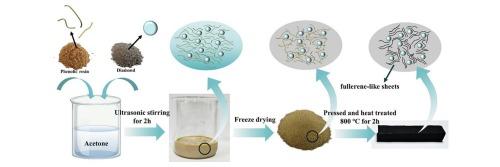Micro-nano diamond reinforced phenolic-derived carbon composites: Promoted structural evolution and performance
IF 8.1
2区 材料科学
Q1 ENGINEERING, MANUFACTURING
Composites Part A: Applied Science and Manufacturing
Pub Date : 2025-08-18
DOI:10.1016/j.compositesa.2025.109254
引用次数: 0
Abstract
Glassy carbon with a curved fullerene-like structure, derived from thermosetting resin, holds great promise as bonding material for diamond grinding wheels particularly in dry grinding applications. In this study, a novel sp2 carbon bonded micro-nanodiamond (MND) composite was fabricated using phenolic resin (PR) as the carbon bond precursor. The influence of MND on the pyrolysis behavior of PR and the evolution of the carbon structure below 1000 ℃ was systematically investigated. Results showed that MND promoted the decomposition of methylene bridges and phenolic hydroxyl groups, thereby facilitating the formation of curved carbon layers and fullerene-like structures in the PR-derived carbon. Additionally, smaller MND grit sizes significantly enhanced the bending strength and wear resistance of the composites, which was attributed to improved interfacial bonding and the catalytic effect of diamond in forming a more ordered carbon structure. These findings offer important guidance for the rational design of high-performance carbon-bonded diamond grinding wheels and shed new light on the advancement of dry grinding technologies in semiconductor processing.

微纳金刚石增强酚醛碳复合材料:促进结构演变和性能
从热固性树脂中衍生出的具有弯曲富勒烯状结构的玻碳,作为金刚石砂轮的粘接材料,特别是在干式磨削应用中,具有很大的前景。本研究以酚醛树脂(PR)为碳键前驱体制备了一种新型sp2碳键微纳米金刚石(MND)复合材料。系统研究了MND对PR在1000℃以下热解行为及碳结构演变的影响。结果表明,MND促进了亚甲基桥和酚羟基的分解,从而促进了pr衍生碳中弯曲碳层和富勒烯样结构的形成。此外,较小的MND粒度显著提高了复合材料的抗弯强度和耐磨性,这是由于界面结合的改善和金刚石的催化作用形成了更有序的碳结构。这些研究结果为合理设计高性能碳结合金刚石砂轮提供了重要的指导,并为半导体加工中干式磨削技术的发展提供了新的思路。
本文章由计算机程序翻译,如有差异,请以英文原文为准。
求助全文
约1分钟内获得全文
求助全文
来源期刊

Composites Part A: Applied Science and Manufacturing
工程技术-材料科学:复合
CiteScore
15.20
自引率
5.70%
发文量
492
审稿时长
30 days
期刊介绍:
Composites Part A: Applied Science and Manufacturing is a comprehensive journal that publishes original research papers, review articles, case studies, short communications, and letters covering various aspects of composite materials science and technology. This includes fibrous and particulate reinforcements in polymeric, metallic, and ceramic matrices, as well as 'natural' composites like wood and biological materials. The journal addresses topics such as properties, design, and manufacture of reinforcing fibers and particles, novel architectures and concepts, multifunctional composites, advancements in fabrication and processing, manufacturing science, process modeling, experimental mechanics, microstructural characterization, interfaces, prediction and measurement of mechanical, physical, and chemical behavior, and performance in service. Additionally, articles on economic and commercial aspects, design, and case studies are welcomed. All submissions undergo rigorous peer review to ensure they contribute significantly and innovatively, maintaining high standards for content and presentation. The editorial team aims to expedite the review process for prompt publication.
 求助内容:
求助内容: 应助结果提醒方式:
应助结果提醒方式:


